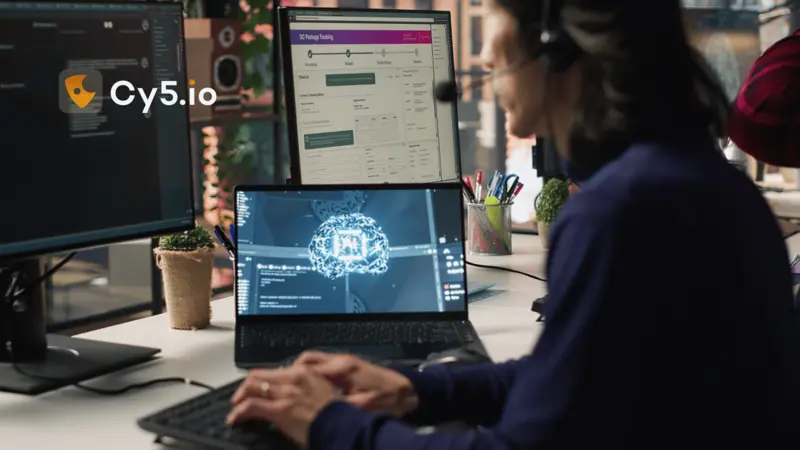Posture tools are great at surfacing thousands of findings—less great at telling you what matters now. Teams drown in tickets while drift and misconfigurations keep returning. The answer isn’t “more alerts.” It’s applied AI with guardrails: narrow the scope, correlate signals, and automate the right next step. This article explains ai for cspm with seven practical use‑cases, governance patterns that keep humans in control, and a scorecard you can use to prove value in 90 days.
For teams already using a graph‑aware CNAPP, such as Cy5’s ion Cloud Security Platform, the workflows below map directly to built‑in capabilities like real‑time discovery and context‑based prioritization.
Key Takeaways
- Where AI helps: classification, clustering, and anomaly techniques prioritize and de‑duplicate—policy remains the source of truth.
- Seven use‑cases: from drift detection and rules gap discovery to evidence mapping for audits—each with a quick workflow sketch.
- Governance essentials: explainability, override paths, and auditable actions by design.
- Proof metrics: precision/recall, engineer hours saved, posture score delta, and audit cycle time.
- Start small, scale fast: pilot two use‑cases, publish weekly scorecards, then expand to compliance evidence.
Where AI fits in posture management (classification, clustering, anomaly) — and where it doesn’t (policy truth)
AI is a force multiplier around your controls—not a replacement for them. Policies and benchmarks (CIS, NIST CSF, CSA CCM) remain the ground truth. AI takes the raw signals from your clouds and ranks, groups, and predicts to reduce noise and speed actions.
- Typical inputs: resource configurations and deltas; identity and permission graphs; network paths/flows; IaC (infrastructure‑as‑code) changes; historical triage/ticket outcomes.
- Core techniques:
- Classification to score and label findings for priority or routing.
- Clustering to group near‑duplicate issues by entity, lineage, or blast radius.
- Anomaly detection to spot behavior or drift outside normal patterns.
- Regression to forecast impact/likelihood (e.g., which change will break a control).
- Rules mining to suggest missing controls based on recurring patterns.
- Classification to score and label findings for priority or routing.
Policy truth: AI shouldn’t write or change controls. It should help you decide which control to apply, where, and when, and provide a reason you can defend to auditors.
AI Building Blocks vs Outcomes
| Technique | Typical inputs | What it’s good at | Where to avoid | Example outcome |
|---|---|---|---|---|
| Classification | Findings, asset metadata, historical labels | Priority scoring, routing to owners | Authoring policies, granting rights | “P1: Public bucket in prod with identity path to internet” |
| Clustering | Entity graphs, config deltas, tags | De‑duplication, campaign‑level fixes | Rare/unique incidents | “Merge 120 similar SG rules into 3 change requests” |
| Anomaly detection | Baselines, time‑series posture metrics | Drift/compliance regressions | One‑off manual exceptions | “Unusual spike in IAM privilege grants this week” |
| Regression | Changes, outcomes, rollbacks | Change‑impact prediction | Sparse or low‑quality data | “This egress change likely breaks control X (80%)” |
| Rules mining | Repeated patterns in findings | Suggesting missing controls | Finalizing policy | “Propose new rule: block public ACLs on creation” |
Where AI helps today — ai for cspm in practice
Use AI to rank the riskiest misconfigs, cluster duplicates across accounts/projects, predict which changes will fail controls, and detect drift before it becomes a ticket storm. Keep humans in the loop for exceptions and policy changes.
Use‑case 1–7: drift detection, rules gap discovery, de‑duplication, entity correlation, false‑positive suppression, change impact prediction, mapping evidence to frameworks
Below, each use‑case includes the problem, inputs, model approach, a quick workflow, a safe action, and a KPI to track.
1) Drift Detection (Prevent Posture Rot Between Scans)
- Problem: Runtime changes bypass IaC and quietly erode your baseline.
- Signals/inputs: Config deltas, IaC plans, change windows, tag/owner data.
- Model approach: Anomaly detection over time‑series posture metrics.
- Workflow sketch:
- Ingest config deltas + IaC plan
- Compare to baseline by environment
- Flag anomalous deviation by severity
- Recommend revert/quarantine
- Log reason codes, owner, and waiver (if any)
- Safe action: Quarantine first (deny public exposure; tag asset).
- KPI: Drift MTTR and % drift auto‑reverted within SLA.
In tools with agentless, real‑time scans, ion can tag suspected drift and route owners automatically while preserving an audit trail.
2) Rules Gap Discovery (Find Controls You’re Missing)
- Problem: Recurring issues indicate a missing or too‑weak control.
- Signals/inputs: Repeated finding types, suppression patterns, exception notes.
- Model approach: Rules mining + clustering on recurring patterns.
- Workflow sketch:
- Cluster recurring findings by type/scope
- Propose candidate control (human review)
- Test as dry‑run in non‑prod
- Stage to prod with change window
- Monitor false positives/waivers
- Safe action: Only suggest policies; require human approval.
- KPI: Recurrence rate drop after policy introduction.
3) De‑Duplication (Collapse Noisy Duplicates Into One Action)
- Problem: One root cause triggers dozens of near‑identical findings.
- Signals/inputs: Entity hierarchy, tags, network paths, IAM lineage.
- Model approach: Clustering by entity lineage and control scope. Graph‑driven correlation (like Astra Alerts) collapses near‑duplicates at the entity level.
- Workflow sketch:
- Group findings by resource lineage
- Select canonical record
- Route a single change request
- Auto‑close merged duplicates on success
- Capture dedupe ratio for tuning
- Safe action: Merge and track at the campaign level (one owner).
- KPI: Dedupe ratio and tickets avoided.
4) Entity Correlation (Rank by Blast Radius and Exploitability)
- Problem: Not all misconfigs are equally reachable or dangerous.
- Signals/inputs: Identity graph, network reachability, internet exposure, data classification.
- Model approach: Classification using reachability + sensitivity features.
- Workflow sketch:
- Build path to data/internet
- Score severity by exploit path
- Prioritize top N with owners
- Suggest least‑privilege f
- Verify, then roll out fleet‑wide
- Safe action: Apply least‑privilege edits with rollback journaling.
- KPI: % high‑risk issues closed per sprint.
If your CSPM supports context‑based ranking, weight reachability and data sensitivity ahead of count‑based severity.
5) False‑Positive Suppression (Learn What Doesn’t Matter)
- Problem: Teams ignore noisy rules and miss real risk.
- Signals/inputs: Prior triage labels, exception tags, incident outcomes.
- Model approach: Classification with reason codes and confidence thresholds.
- Workflow sketch:
- Train on labeled “ignored” vs “actioned” findings
- Assign confidence + reason code
- Auto‑snooze low‑confidence items
- Send reviewer queue for edge cases
- Retrain monthly on feedback
- Train on labeled “ignored” vs “actioned” findings
- Safe action: Snooze, don’t delete; keep audit trail of suppressions.
- KPI: Alert precision and engineer hours saved.
6) Change Impact Prediction (Know What Will Break Before it Does)
- Problem: A planned change silently breaks a control after deploy.
- Signals/inputs: Proposed diffs, past rollbacks, failure logs, seasonality.
- Model approach: Regression + SHAP‑style explanations.
- Workflow sketch:
- Evaluate proposed diff pre‑merge
- Predict control failures + confidence
- Require waiver or redesign if risky
- Gate by severity SLA
- Compare prediction vs outcome for tuning
- Evaluate proposed diff pre‑merge
- Safe action: Require break‑glass waivers for high‑risk predictions.
- KPI: Change‑failure rate and mean time to rollback.
7) Evidence Mapping to Frameworks (Less Time Proving, More Time Improving)
- Problem: Audits consume weeks collecting artifacts across clouds.
- Signals/inputs: Control catalog, posture logs, CI/CD attestations, data lineage.
- Model approach: Classification + rule‑based mapping to control statements.
- Workflow sketch:
- Ingest control outcomes and logs
- Map to CIS/NIST/CCM controls
- Generate evidence packets (time‑bounded)
- Route to control owners for sign‑off
- Store immutable audit trail
- Ingest control outcomes and logs
- Safe action: Evidence generation only; no policy changes.
- KPI: Audit evidence cycle time and % controls with continuous coverage.
The 7 AI Use‑Cases at a Glance
| Use‑case | Primary model(s) | Signals/data required | Output | Action example | KPI |
|---|---|---|---|---|---|
| Drift detection | Anomaly detection | Config deltas, IaC, baselines | Drift alert + severity | Quarantine or revert | Drift MTTR, % auto‑reverted |
| Rules gap discovery | Rules mining, clustering | Recurring findings, waivers | Policy suggestion | Propose new guardrail | Recurrence rate ↓ |
| De‑duplication | Clustering | Entity lineage, tags | Canonical ticket | Merge 100→1 tasks | Dedupe ratio, tickets avoided |
| Entity correlation | Classification | Identity/network paths, data sensitivity | Risk score | Least‑privilege fix | % high‑risk closed |
| False‑positive suppression | Classification | Labeled history, exceptions | Confidence + reason | Auto‑snooze low value | Precision, hours saved |
| Change impact prediction | Regression | Diffs, past rollbacks | Failure likelihood | Require waiver or redesign | Change‑failure rate, MTTRb |
| Evidence mapping to frameworks | Classification + rules | Control logs, CI/CD attestations | Control‑mapped evidence | Build audit packets | Audit cycle time, coverage % |
Governance: Explainability, Override Paths, Audit Trails
AI that isn’t explainable won’t survive security review—or audit. Build governance in from day one.
- Model cards: document purpose, inputs, limitations, and drift monitoring.
- Feature transparency: log which signals drove each decision and reason codes a human can read. Platforms that surface why a decision was made (e.g., ‘reachable via IAM path + public ingress’) improve review speed.
- Confidence thresholds: act automatically only above a clear bar; below that, queue for review.
- Human‑in‑the‑loop: reviewer queues, explicit override paths, and time‑boxed exceptions.
- Risk controls: rate‑limit actions, scope by tags/projects, and enforce change windows.
- Audit trails: immutable logs that chain evidence to decisions and actions.
AI Governance Checklist for CSPM
| Control | What it ensures | Owner | Artifact/Evidence | Review cadence |
|---|---|---|---|---|
| Model card | Documented scope & limits | Security Eng | Model README | Quarterly |
| Reason codes | Human‑readable decisions | Platform Eng | Decision logs | Monthly |
| Confidence thresholds | Safe automation gates | Security Eng | Threshold config | Monthly |
| Human override | People stay in control | App Owner | Waiver + approvals | per‑exception |
| Exception time‑box | Exceptions expire | Compliance | Expiry report | Weekly |
| Action rate‑limits | Prevent runaway changes | SRE | Rate‑limit config | Weekly |
| Audit trail retention | Evidence is durable | Compliance | Immutable logs | Annual policy |
Proof Points to Collect (Alert Precision, Engineer Hours Saved, Audit Cycle Time)
Executives want measurable progress, not more dashboards. Define baselines first, then report deltas weekly.
- Alert precision/recall: Are we suppressing safely and catching what matters?
- Tickets avoided: How many issues were merged or never created thanks to de‑dup/suppression?
- Engineer hours saved: Roughly hours avoided = (tickets avoided × avg minutes per ticket).
- Posture score delta: Control pass rates or benchmark scores, before vs after.
- Audit cycle time: Time to assemble evidence packs for a framework in scope.
CSPM AI Scorecard
| Metric | Definition | Formula | Target/Threshold | Owner | Reporting cadence |
|---|---|---|---|---|---|
| Alert precision | Correct “actionable” flags ÷ all flagged | TP ÷ (TP+FP) | ≥ 0.8 after 60 days | Sec Eng | Weekly |
| Alert recall | Actionable caught ÷ actionable total | TP ÷ (TP+FN) | ≥ 0.7 after 60 days | Sec Eng | Weekly |
| Tickets avoided | Issues merged/suppressed upstream | Duplicates merged + snoozed | +50% by week 8 | Platform | Weekly |
| Engineer hours saved | Time reclaimed from triage/closure | Tickets avoided × avg mins | 40–80 hrs/mo/team | PMO | Monthly |
| Posture score delta | Benchmark improvement | Current − baseline | +10–20 pts in Q1 | Sec Eng | Monthly |
| Audit cycle time | Evidence assembly time | End‑to‑end hours | −50% by week 12 | Compliance | Quarterly |
90‑day pilot plan (week‑by‑week)
- Weeks 1–2: Instrument data sources; define baselines; choose two use‑cases (e.g., de‑dup + drift).
- Weeks 3–4: Dry‑run models; publish reason codes; set confidence thresholds; no auto‑actions yet.
- Weeks 5–8: Turn on limited auto‑snooze and de‑dup; add reviewer queue; start weekly scorecards.
- Weeks 9–12: Add change‑impact predictions for high‑risk diffs; wire evidence mapping for one framework; present business impact.
Cy5 Value‑Add: Security Observability + Continuous Compliance
Cy5 amplifies these AI use‑cases with agentless visibility and context‑rich analytics across clouds, identities, and runtime. Teams prioritize confidently, suppress noise safely, and generate audit‑ready evidence—keeping security observability + continuous compliance as the north star. Explore the Cy5 Cloud Security Platform and learn how we support Continuous compliance.
FAQs: AI for CSPM
Noise reduction via classification, correlation by graph context, drift detection against baselines, change‑impact prediction for IaC, evidence mapping for audits; policy remains human‑defined (align to NIST CSF / CIS / CSA CCM).
By creating baselines for normal posture and behavior and flagging deviations likely to matter—like a sudden surge in public resources or privilege grants—so you review fewer, higher‑quality alerts. Pair anomalies with reason codes and confidence thresholds.
Position CSPM as configuration/posture focus; CNAPP unifies CSPM, CIEM, vulnerability, and runtime; CWPP is workload protection. AI primarily enhances prioritization and de‑dup across CSPM/CNAPP; runtime models feed context back into posture.
Begin with read‑only baselines in non‑prod. Run drift models in dry‑run, tag suspect changes, and notify owners. Only then enable quarantine/revert actions in off‑hours with rollback plans and rate‑limits.
Use reviewer queues for low‑confidence decisions, break‑glass approvals for high‑impact actions, and time‑boxed waivers with explicit owners. Log reason codes, inputs, and outcomes to an immutable trail tied to each control.
Train on triage history, apply confidence thresholds and reason codes, and feed graph reachability (identity/network paths + data sensitivity). Snooze—don’t delete—low‑value alerts; retrain monthly. See context‑based prioritization for practical scoring patterns.
Aggregate control outcomes, classify against the framework, and export time‑bounded evidence packets. Route to owners for sign‑off and retain immutable trails. CSA CCM v4 offers structure that maps to common controls across providers.
Conclusion
Start small: pick two use‑cases (de‑duplication and drift), publish a weekly scorecard, and prove fewer tickets and faster remediation. In month two, add prediction for high‑impact changes. In month three, wire evidence mapping so audits take hours, not weeks. With guardrails and measurement, AI becomes a reliability feature of your posture program—not a black box.





